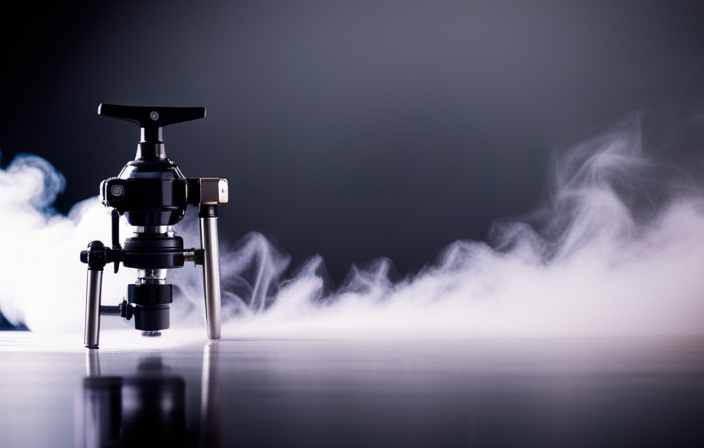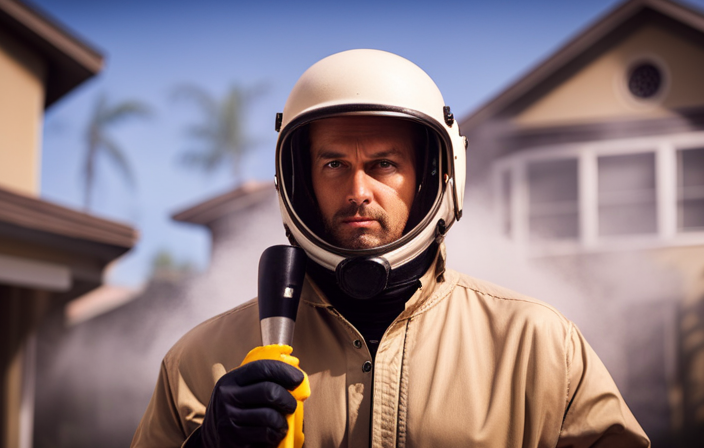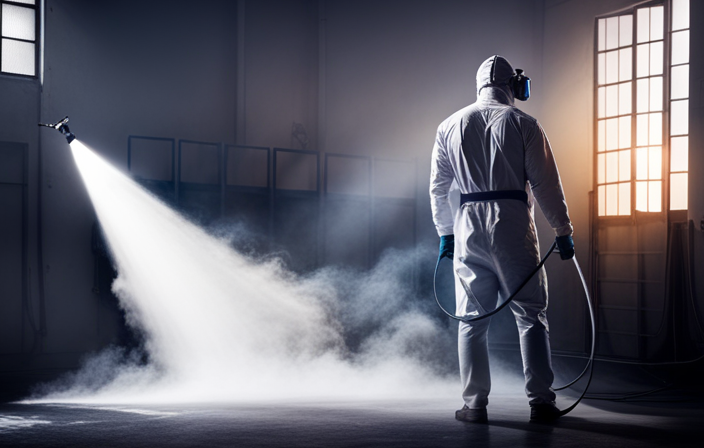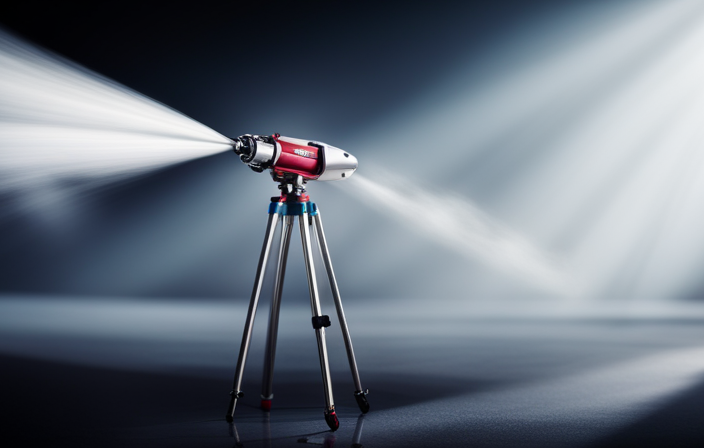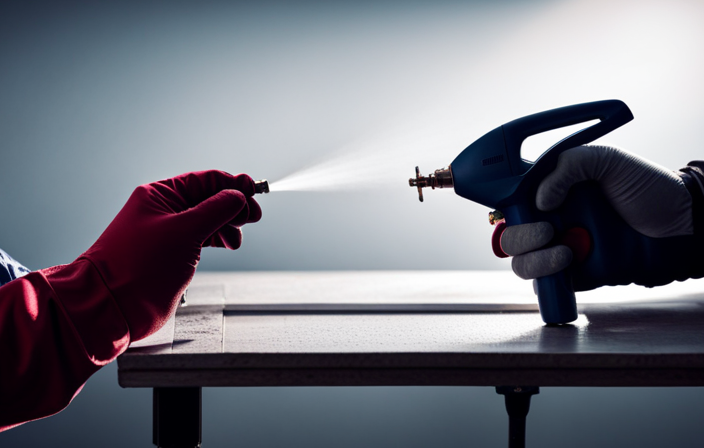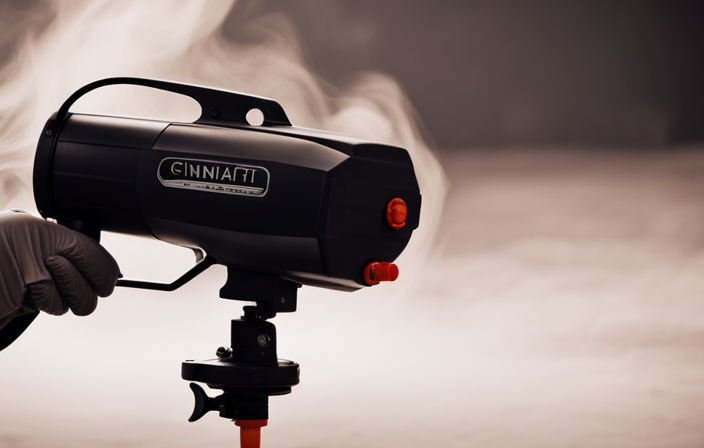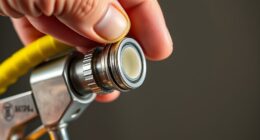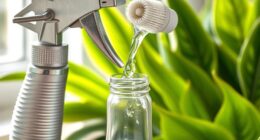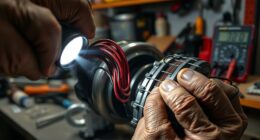Have you ever fantasized about having a magic wand that could effortlessly give your walls a fresh coat of paint?
Well, let me introduce you to the airless paint sprayer – the closest thing to a painting wizard that you’ll ever encounter.
This ingenious device removes the need for traditional brushes and rollers, allowing you to cover large surfaces in record time.
With its powerful pumping system, precise pressure control, and efficient paint delivery system, the airless paint sprayer revolutionizes the way we tackle painting projects.
But how does it actually work?
In this article, we will delve into the inner workings of this remarkable tool, exploring the pumping system, pressure control system, paint delivery system, and the crucial nozzle and tip.
We will also discuss safety considerations, maintenance, and cleaning, as well as share some tips and tricks to help you make the most out of your airless paint sprayer.
So, get ready to uncover the secrets behind this paint-spraying marvel!
Key Takeaways
- Airless paint sprayers use high pressure to atomize paint and create a fine spray pattern.
- Regular maintenance, including cleaning filters and lubricating parts, is essential for optimal performance.
- Proper surface preparation and technique, such as holding the sprayer at a consistent distance and using controlled motions, are important for achieving smooth, streak-free results.
- Troubleshooting issues like uneven spray patterns or loss of pressure can often be resolved by checking filters, adjusting pressure, or inspecting the spray tip.
The Basics of Airless Paint Sprayers
The functionality of airless paint sprayers is rooted in their ability to atomize paint without the need for compressed air. Unlike traditional paint sprayers that rely on air pressure to disperse paint particles, airless paint sprayers use a high-pressure pumping system to force paint through a small nozzle, creating a fine mist of paint.
This technique allows for a more even and consistent application of paint, resulting in a professional-looking finish. One of the major benefits of using an airless paint sprayer is its ability to cover large areas quickly and efficiently. This method is especially useful for painting large surfaces such as walls or fences.
Additionally, airless paint sprayers can handle a wide range of paint types, from thick latex paints to thin stains. The pumping system of the sprayer is responsible for generating the necessary pressure to propel the paint through the nozzle, which will be discussed in the subsequent section.
The Pumping System
To understand how it functions, imagine yourself operating an airless paint sprayer and witnessing the powerful pumping system in action. The pumping system is the heart of the airless paint sprayer, responsible for pressurizing and delivering paint to the nozzle. It consists of a motor that drives a piston or diaphragm, creating the necessary pressure to atomize the paint.
Proper maintenance of the pumping system is crucial for optimal performance. Regularly cleaning the filters and checking for any clogs or blockages will ensure a smooth operation. Troubleshooting tips for the pumping system include checking for leaks, inspecting the seals and gaskets, and adjusting the pressure settings.
Understanding how the pump works sets the stage for the next section about the pressure control system, which allows for precise regulation of paint flow and fan width.
The Pressure Control System
Imagine operating an airless paint sprayer and witnessing the powerful pumping system in action, which is responsible for pressurizing and delivering paint to the nozzle. However, the pumping system alone is not enough to ensure an efficient and controlled paint application. That’s where the pressure control system comes into play.
The pressure control techniques employed in airless paint sprayers allow for precise control over the spray pattern and the amount of paint being applied. By adjusting the pressure, you can achieve different spray patterns, such as a narrow fan or a wide fan, depending on your project requirements. This level of control ensures uniform coverage and reduces overspray, saving both time and paint.
The benefits of pressure control in an airless paint sprayer are undeniable, as it allows for professional-quality results with minimal effort.
Now, let’s move on to the next section and explore the paint delivery system.
The Paint Delivery System
Operating an airless paint sprayer requires understanding the intricacies of the paint delivery system. This system ensures precise and efficient application of paint.
The paint delivery system consists of a pump that pressurizes the paint and a hose that delivers it to the spray gun. As the pump forces the paint through a small orifice, it atomizes the paint, breaking it up into tiny particles. The size of these particles can be adjusted by controlling the pressure and the size of the orifice.
Additionally, the paint viscosity plays a crucial role in how well the paint atomizes. Thicker paints may require higher pressures to achieve proper atomization.
The paint delivery system is responsible for delivering the atomized paint to the nozzle and tip. From there, it is sprayed onto the surface.
The Nozzle and Tip
The nozzle and tip work in unison, creating a delicate dance as they release a fine mist of color onto the waiting canvas. The nozzle is the final point of exit for the paint, responsible for shaping and directing the spray pattern. It is crucial to keep the nozzle clean and free from any clogs or debris to ensure a smooth and consistent flow of paint. Regular nozzle maintenance is essential for optimal performance and longevity of the airless paint sprayer.
Tip selection is another important aspect of achieving the desired results. The tip determines the size of the spray pattern and the amount of paint that is delivered. Different tips are available for various applications, allowing for versatility and customization. It is important to choose the right tip for the specific project to achieve the desired coverage and finish.
Moving forward, understanding spray patterns and coverage will further enhance the painting process.
Spray Patterns and Coverage
Get ready to witness the captivating artistry of spray patterns and coverage as you discover the incredible versatility and precision they bring to your painting experience.
Spray patterns refer to the shape and size of the paint particles being emitted from the nozzle. The airless paint sprayer offers various spray techniques, including horizontal, vertical, and circular patterns, allowing you to achieve different effects on different surfaces.
The coverage of the spray pattern depends on the paint thickness and the distance between the sprayer and the surface. Thicker paint requires a wider spray pattern, while thinner paint requires a narrower pattern for better control and even coverage.
Safety considerations should never be overlooked, as the high pressure of the sprayer can cause paint to atomize and become airborne. So, let’s now explore the important safety measures to ensure a smooth painting process.
Safety Considerations
Let’s dive into the essential safety measures to ensure a smooth and worry-free painting experience. When using an airless paint sprayer, it’s crucial to take certain safety precautions to protect yourself and others. Here are some key points to keep in mind:
-
Always wear appropriate protective gear, including gloves, safety glasses, and a respirator, to shield yourself from potentially harmful paint particles and fumes.
-
Make sure the work area is well-ventilated to minimize the inhalation of paint vapors.
-
Avoid spraying near open flames or sparks to prevent fire hazards.
-
Before starting, carefully read and follow the manufacturer’s instructions and safety guidelines.
-
Keep children and pets away from the work area to prevent any accidents or exposure to paint chemicals.
By adhering to these safety precautions and wearing the necessary protective gear, you can ensure a safe and efficient painting process.
Moving on to maintenance and cleaning, it’s important to…
Maintenance and Cleaning
To ensure a smooth and worry-free painting experience, remember to properly maintain and clean your equipment. Regular maintenance of your airless paint sprayer is essential for optimal performance.
Here are some maintenance tips to keep in mind. First, always check the manufacturer’s guidelines for specific instructions on maintenance and cleaning. Inspect the sprayer for any signs of damage or wear before each use. Clean the filters regularly to prevent clogs and ensure a consistent spray pattern. Additionally, lubricate the pump and other moving parts as recommended by the manufacturer.
When it comes to cleaning techniques, make sure to thoroughly flush out the sprayer after each use to remove any leftover paint or debris. Use a cleaning solution recommended by the manufacturer and follow their instructions carefully.
By following these maintenance tips and cleaning techniques, you can keep your airless paint sprayer in top condition for years to come.
Now, let’s move on to some tips and tricks for using an airless paint sprayer.
Tips and Tricks for Using an Airless Paint Sprayer
Mastering the art of using an airless paint sprayer is like effortlessly wielding a magic wand, effortlessly transforming a blank canvas into a vibrant masterpiece. To improve efficiency and achieve professional results, here are some tips and tricks:
-
Properly prepare the surface: Clean it thoroughly, remove any loose paint or debris, and repair any cracks or imperfections. This will ensure a smooth and even finish.
-
Use the right technique: Hold the sprayer at a consistent distance from the surface, usually around 12 inches. Move your arm in a steady, controlled motion, overlapping each pass by 50% to avoid streaks.
-
Troubleshooting common issues: If the paint is coming out unevenly, check the nozzle for clogs and adjust the pressure settings accordingly. If there are drips or runs, reduce the pressure and increase the speed of your strokes.
In the next section, we’ll discuss how to choose the right airless paint sprayer for your needs, ensuring that you have the perfect tool for your painting projects.
Choosing the Right Airless Paint Sprayer for Your Needs
If you’re looking to become a painting wizard, finding the perfect wand for your artistic endeavors can make all the difference.
When choosing the right airless paint sprayer for your needs, it’s important to consider factors such as the size of your projects, the type of paint you’ll be using, and your budget.
Additionally, proper maintenance and troubleshooting are key to keeping your airless paint sprayer running smoothly. Regular maintenance, including cleaning and lubricating the sprayer, can prevent clogs and ensure consistent paint flow.
Troubleshooting common issues like uneven spray patterns or loss of pressure can be done by checking the filters, adjusting the pressure settings, or inspecting the spray tip for damage.
By selecting the right airless paint sprayer and maintaining it properly, you’ll be well on your way to achieving professional-quality paint jobs.
Frequently Asked Questions
Can I use an airless paint sprayer for any type of paint or coating?
Yes, an airless paint sprayer can be used for any type of paint or coating, including automotive painting and furniture refinishing. It provides efficient and even coverage, making it a versatile tool for various applications.
How long does it typically take to clean and maintain an airless paint sprayer?
Cleaning and maintaining an airless paint sprayer typically takes about 15-30 minutes. It’s important to clean it after each use to prevent clogs and ensure optimal performance. Regular maintenance, such as changing filters and lubricating parts, should be done according to the manufacturer’s recommendations.
Are there any safety precautions I should take when using an airless paint sprayer?
When using an airless paint sprayer, it is important to take safety measures to protect yourself. Wear proper equipment such as goggles, gloves, and a mask to prevent any potential hazards or inhalation of paint particles.
Can I use an airless paint sprayer for large-scale projects such as painting the exterior of a house?
Yes, an airless paint sprayer is ideal for large-scale projects like painting the exterior of a house. With its high pressure and wide spray pattern, it can cover large areas quickly and efficiently, saving you time and effort.
Are there any specific techniques or tricks I should know when using an airless paint sprayer for the best results?
When using an airless paint sprayer for the best results, there are a few specific techniques and tricks to keep in mind. Properly adjusting the pressure, maintaining a consistent speed, and overlapping each pass will ensure a smooth and even coat.
Conclusion
In conclusion, using an airless paint sprayer can greatly simplify and expedite your painting projects. You can achieve professional-looking results in no time with its efficient pumping system, precise pressure control, and effective paint delivery system. But remember, safety should always be a top priority, so make sure to follow the manufacturer’s instructions and wear protective gear.
Finally, when choosing the right airless paint sprayer, consider factors such as the size of the project and the type of paint you’ll be using. So why settle for tedious brush strokes when you can effortlessly transform any surface with an airless paint sprayer?
